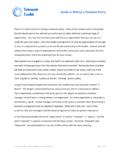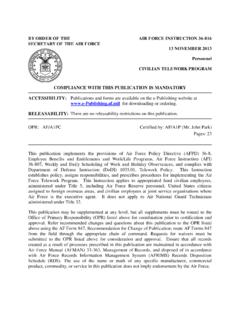Transcription of Measuring Telework ROI: Metrics Based on the …
1 For several years, HR professionals have heard about the individualand organizational benefits of integrating Telework into the workenvironment. ITAC, the Telework advisory group of WorldatWork,broadly defines teleworkas working from anywhereand reports such benefitsas higher organizational commitment, reduced employee absenteeism,increased levels of job satisfaction and reduced turnover rates amongemployees who Telework (Davis and Polonko 2001). These statistics are powerful because they provide concrete measurementoutcomes of the organization s return on investment (ROI) related totelework. By creating and tracking these Metrics and measurements,organizations can clearly illustrate the benefits they receive from providingand supporting Telework , whether it is via a formal program or informalprocess (See Figure 1 on page 7.)
2 Whether a program is formal orinformal, Metrics are the strongest evidence Telework supporters can collectto persuade key stakeholders to support and fund remote-work initiatives. Unfortunately, most organizations do not track Telework s ROI, whetherthe program is formal or informal. Fundamentally, Metrics are overlookedfor three reasons: 0lack of measurement expertise/know-how0they are viewed as labor-intensive and Measuring Telework ROI: Metrics Based on the Employee Life CycleJennifer M. Verive, Rabbit Virtual DeLay, Journal second quarter 2006 Contents 2006 content is licensed for use by purchaserssolely for their own use and not for resale or redistribution. No part of thisarticle may be reproduced, excerpted or redistributed in any form withoutexpress written permission of WorldatWork and appropriate WorldatWork at 480/922-2020; of accountability regarding Telework within theorganization.
3 Lacking key indicators of success, it is unsurprisingthat many pilot Telework programs fail to move to fullimplementation, existing programs fail or informaltelework becomes the norm within Telework s identified benefits and the challenges of measurement, this paper provides guidance on how todevelop and track Telework ROI the key strategic benefitsthat a Telework program can provide to an paper illustrates how to integrate teleworkmeasurement into existing HR measurement programsusing a comprehensive employee life cycle Employee Life Cycle Measurement ModelMany Fortune500 companies now have HR researchfunctions in-house. Generally, the function of this job is to develop and implement measurement across theemployee life cycle. While this practice is not universalin implementation, in theory it is a universally acceptedconcept.
4 A few organizations have developed well-thought-out employee life cycle measurement systemswith measurement tools dovetailing to tell a cohesivestory of employee life from attraction to exit. The nature of measurement is such that Metrics aretypically not developed at one period in time tomeasure across all employee life cycle phases. If theoverarching model is in place, however, when metricsare developed, the model s architecture informs thelinkage in the individual measurement tools. Becausethe practice of Telework often is ingrained within thefabric of an organization, leveraging measurement toolsin place, or being developed, is the perfect opportunityto understand Telework s impact within an span of employees engagement with anorganization can be broken into four phases with eachimpacting organizational image: attraction, joining,performing and leaving the organization.
5 Figure 2 onpage 8, The Employee Life Cycle Measurement Model,adapted from Colquitt and Macey (2005), depicts thesephases and the related processes that measurementduring each phase can influence. Starting at the top of the model, the first phase isAttract. This phase is coupled with recruiting an individual is recruited into an organization,the onboarding/Joinprocess begins. Measurementaround this phase of the relationship is typicallyassociated with selection and socialization/onboardingassessment. The employee is then integrated into theorganization and the focus becomes to EngageandRetain the individual, often the most measurement-intensive phase. Examples of measurement during thisstage can be from early hire through retirement. Theseexamples include: performance management, upwardfeedback and employee opinion surveys.
6 The finalphase for employees occurs when they Leavetheorganization. This phase is linked to exit measurementssuch as data gathered in exit interviews. When a comprehensive employee life cycle model isused within an organization, information gathered duringone phase may serve as feedback into any other life cyclephase, not necessarily simply looped back into the phaseto which it is coupled. The circular arrows in the middleof the diagram illustrate this integrative a life cycle model to develop and track teleworkmetrics is helpful as it provides a logical framework for examining Telework s impact on key organizationalindicators. Additionally, the model helps ensure that the full ROI of Telework is assessed because it covers all phases of employee experience. Finally, the life cycle7 WorldatWork Journal second quarter 2006 FIGURE 1 Formal Versus Informal TeleworkFormalInformalPolicies and ProceduresNo Policies and Procedures (Ad hoc)TrainingNo TrainingAccountability at the Accountability.
7 None or IndividualIndividual, Departmental and Organizational levelsDesignated FundingNo Designated Fundingmodel provides both specificity in measurement (eachof the four phases) as well as the big picture view that is essential in understanding any initiative s effecton the Primer On Telework ROI MetricsMetrics quantify the benefits of Telework and, for aformal program, demonstrate return on stories about how some employees liketelework are helpful, but clear, hard numbers convincestakeholders to support sound, reliable Metrics to capture ROI oftenis perceived as an art form. Indeed, many organizationsdo not have adequate measurements in place becausethese efforts can be time- and resource-intensive. However,such effort is necessary because the only way anorganization can measure its return on investment, or the benefits of a particular program, whether formal or informal, is by collecting specific, relevant data.
8 Fortunately, the Employee Life Cycle MeasurementModel is an excellent guide for developing teleworkmetrics. The four phases suggest not only what types ofthings or processes might be measured, but also whereone can look to find those numbers. Using the modelas a guide, the following steps provide a quick how to on developing the types of Metrics that support andsustain Telework 1: Identify Strategic Initiatives Metrics Measuring return on investment must link to an organization s key goals. For example, if anorganization is striving to be in its marketplace,then good ROI Metrics are those demonstrating theorganization s high-level performance. Specific metricsfor this type of strategic goal might include data onemployee productivity, customer satisfaction andproduct enhancements/quality improvements.
9 Thus, the first step is to examine the various initiatives8 WorldatWork Journal second quarter 2006 Develop,Evaluate,PromoteSelect/HireEngag e/RetainRecruitExitAttractLeaveJoinMeasu reFIGURE 2 The Employee Life Cycle Measurement Modeland programs at an organization and determine whichare strategic. Piggybacking on or leveraging these sorts of efforts ensures that key stakeholders are interested in the Metrics that are to be tracked. Next, consider how Telework might positively impact these key initiatives and at what levels. The Levels of Telework Metrics box (See Figure 3)shows how measurements may be taken at differentlevels, from Individual to Community. Thinking aboutmeasurements in this way helps develop a list of thetypes of data that must be collected. With this inmind, move to the second 2: Identify the Measurements Already Being TrackedMost organizations already collect a great deal of datavia ongoing events such as annual employee opinionsurveys, employee performance reviews, customersatisfaction surveys, production data and so on.
10 Explorethe measurements the organization already tracks to seeif any cover the type of data identified in Step 1. Existingmeasurements are particularly compelling because theycan be used to develop before and after statistics topowerfully demonstrate the impact of the organization doesn t track certain neededmeasurements, a variety of third-party sources providerelevant benchmarking data for similar organizations (See Figure 4). Although not as compelling asorganization-specific data, they are useful and 3: Consider Creating New Metrics Possibly, an existing measurement is not tracking thedata an organization is most interested in collecting. In this case, get creative and develop needed creating Metrics may be more time-consuming,it s also an excellent opportunity to develop a custommeasurement specific to Telework .




